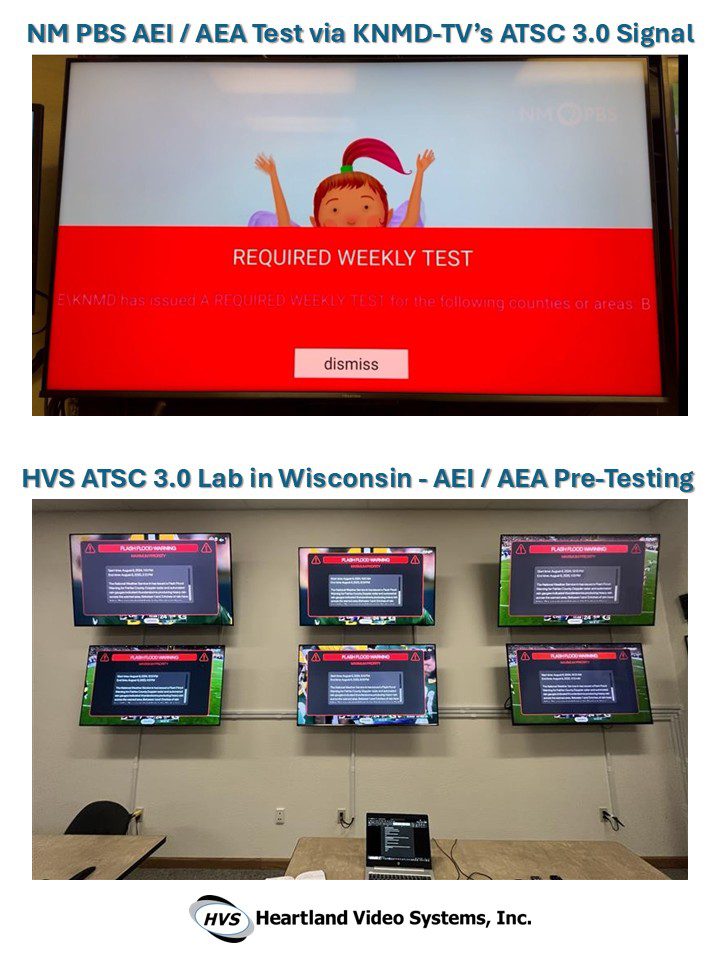PLYMOUTH, Wis. — April 3, 2025 — Heartland Video Systems, Inc. (HVS), a premier video systems integration and consulting firm, announces that our ATSC 3.0 expert team has assisted New Mexico PBS (NMPBS) to optimize their existing ATSC 3.0 over-the-air (OTA) signal with Advanced Emergency Information (AEI) / Advanced Emergency Alert (AEA) capability. In addition, HVS supplied NMPBS the necessary equipment for the country’s very first ATSC 3.0 translator that works in conjunction with their existing ATSC 3.0 facility.

Advanced Emergency Information (AEI) is a new capability within the ATSC 3.0 TV standard available to all broadcasters. The current Emergency Alert System (EAS) was deployed in the late 90’s and provides standardized messaging for DTV and radio broadcasters. In ATSC 1.0, the EAS signal is implemented via audio messaging and is usually accompanied with a text crawl across the live video program. It is important to remember that EAS is mandatory for ATSC 1.0 and 3.0 OTA broadcasts.
AEI is in addition to EAS and supplements the warnings with additional real-time data customized to the region or type of emergency. AEI can also be used to provide non-emergency information such as school closings, traffic updates, and other community specific alerts. And consumers will have the ability to opt in or out for AEI updates.
To take full advantage of AEI, a TV station needs to implement a Broadcaster App (BA) as part of their OTA signal. The BA is used in the consumer’s ATSC 3.0 receiver providing the ability to properly render or display the AEI information on the consumer’s NextGenTV display. HVS worked closely with NMPBS to implement their AEI solution by partnering with Digital Alert Systems and EiTV USA to configure, test, and deploy an end-to-end AEI+BA solution on NMPBS’ KNMD-TV ATSC 3.0 station in Santa Fe, NM.
The EiTV USA team led the development of a Broadcast App (BA) delivered over the broadcast signal to ensure the reception of Advanced Emergency Information (AEI) messages on a wide range of TVs and set-top boxes. While AEI follows a standard, not all devices are fully compliant, making the BA essential for guaranteeing that AEI information is correctly received and displayed across different receivers.
“Our main challenge was ensuring that the app consistently supported the display of AEI-MF messages and all associated multimedia content—including video clips, audio, and graphic files—across all ATSC 3.0 receivers while maintaining a uniform look and feel,” said Rodrigo Cascao Araujo, CEO of EiTV USA.
“ATSC 3.0 will transform public alerting and targeted messaging to audiences. Digital Alert Systems and our DASDEC™ messaging platform play a central role in the Advanced Emergency Information infrastructure,” said Ed Czarnecki, VP of Global and Government Affairs at Digital Alert Systems. “As shown here at KNME, integrating our proven emergency messaging solutions with the power of NextGen TV will enable broadcasters to deliver faster, more informative, and more accessible messaging directly to audiences than ever before. With the DASDEC already at over 80% of U. S television stations, we are showing how this can be a seamless, cost-effective, and modular open-architecture migration for broadcasters.”
“HVS worked with KNME, EiTV, and Digital Alert Systems to develop an AEI solution. Because of the wide variances in how the different manufacturers, models, and years of the TV’s and set top devices behaved, we used our fully functional ATSC 3.0 lab to mock up KNME’s on air system and run many months of tests and report back findings to EiTV. The data was mostly reports of how the different devices behaved with the app look, the remote buttons behavior, audio behavior, and the actual test message display. Getting all devices to eventually have a common look and feel was a challenge. This was an iterative process, but eventually HVS and EiTV achieved the end goal of a fully functional app. Throughout the process, Ed Czarnecki at Digital Alert Systems provided expert advice about AEI that proved to be very helpful. HVS then worked with KNME and Digital Alert Systems to get connectivity between the DASDEC and the ATSC 3.0 broadcast equipment, program the DASDEC for AEI, set up various AEI data sources, and run on air tests. This is a big milestone for HVS and we were excited to be part of such ground breaking work.” said Mike Schmidt, HVS Sr. Engineer, ATSC 3.0 Specialist
New Mexico PBS also operates over 35 translators primarily covering the northern half of the state. Their first translator site that will transition to ATSC 3.0 service will be K33QV-D in Tres Piedras, NM. K33QV-D will augment K28GV-D currently on ATSC 1.0 and the new translator will receive an ATSC 3.0 off-air signal from KNMD-TV including the new AEI+BA capability. For K33QV-D, HVS supplied a BE-TV25-GFU 25W ATSC 3.0 translator. K33QV-D is the very first ATSC 3.0 translator licensed by the FCC and the station is expected to be on-the-air by mid-2025. NMPBS intends to transition additional translator sites to ATSC 3.0 in 2025.
“New Mexico PBS is proud to help lead the industry toward better emergency alerting. We have partnered with Heartland Video Systems on our ASTC 3.0 project since our adoption in 2021 and eagerly came on board when they asked us to participate in AEA testing. Public television is the backbone of the emergency alerting system in the United States and we are excited to help the system evolve and advance.” said Jason Quinn Director of Engineering At New Mexico PBS